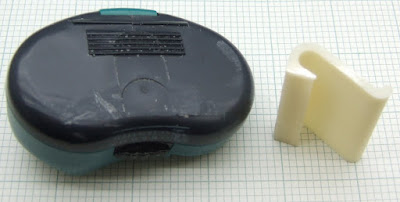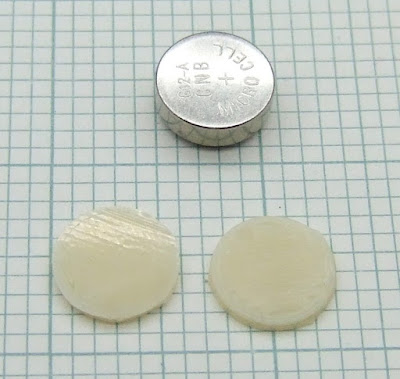My
first attempt at extruding ABS onto hot Kapton had "
all the stops pulled out" to make it stick, i.e. 120°C bed, nozzle height 0.1mm too low, very slow outline and infill on the first layer (4mm/s). The adhesion was very good so I decided to back off a bit. It is not a good idea to change more than one thing at a time but I did anyway. I got rid of the -0.1mm Z offset and sped up the first layer infill to 32mm/s, leaving the outline at 4mm/s. I also dropped the bed temperature to 80°C. That was too low, the corners lifted about 1mm during the build, but I think the part will still be usable.

The base is still glossy but you can see and feel some valleys between the extrusion "lanes". The next test was a
binary chop with the bed at 100°C.

This is perfectly flat, even when off the bed for a day, but the extrusion lanes are still noticeable. The next test was at 110°C.

The extrusion lanes are gone in most places but a few are just visible. The first one that I did at 120°C has no extrusion lanes on it all, just some very slight graining from the Kapton tape that you can also see on the picture above. The tape lines and grain go from bottom right to top left. The extrusion infill slopes bottom left to top right and is only visible on the right hand side of the object. I think perhaps Z has to be a bit lower to get rid of them completely, but it is only important if you want to make something aesthetic, like an instrument panel, for example.
Of course there are the tape join marks. I used unbranded
polyimide as it seems to be about half the price of branded Kapton. I got it from
here, which is very cheap and free shipping if you don't mind waiting a while. You can get polyimide tape up to 250mm wide, but it is always on a 33m roll, so it gets very expensive. I have ordered a 150mm roll to cover the working area of HydraRaptor's build table. It was £53.71 from
here, so very expensive, but a small price to pay for perfection! I don't know when it will arrive as post is a nightmare at the moment. I am still waiting for things from the 17th of December. Parcels are not being delivered because of the snow, so you have to go and collect them, but several letters and packets seem to have disappeared.
Here are all the tests side by side, notice the colour change with temperature, it is a bit exaggerated on the photo : -

I now have a full set of Mendel vertexes including two that I made in PLA that warped slightly (on a cold bed). I moved onto something more ambitious on the warping front: the Mendel x-carriage-lower_1off part. I don't think this is printable in ABS without a
heated platform, or
air stream, unless you use the
apron method developed by Forrest Higgs. For this test I started the bed at 120°C and dropped it to 100°C after the first layer. The logic being that 100°C seems to be enough to prevent warping, but 120°C is needed to get a perfectly smooth finish. It takes a few layers before the temperature has dropped to 100°C as I don't wait for the plate to cool down.

Unfortunately the ancient version of Skeinforge that I use gets one layer wrong on this part. The layer has the central hole missing. The filament didn't span the void very well as it is a very big void, I have no fan running and there is a lot of heat rising from the bed. That caused some filament to stick up and collide with the head. It spun round 90° unscrewing it 1/4 of a turn. Amazingly it did not leak but the nozzle hole must be slightly off centre with respect to the barrel thread, so I got an offset in X and Y above the layer that went wrong. Still, the objective was to test warping and it came out totally flat.

The corners have a dimple that looks like an air bubble, but must be something to do with them trying to lift I think. Apart from these the base is as flat as glass and had it not been for the Skeinforge bug it would have been usable straight off the bed. I cut the membrane out with a knife and drilled through the blinded holes before taking these pictures.

I tried the x-carriage-upper_1off starting the bed at 120°C for the first layer and dropping to 90°C. Again Skeinforge got it wrong, not surprising as the topology is very similar. This time I also dropped the filament temperature to 220°C, so it spanned better and the head did not get spun. A longer snout on the nozzle might be a good idea to avoid collisions with build defects.

Again here it is with the membrane removed.

The corners lifted very slightly but the rest of the base is completely flat. It doesn't rock on a flat surface like an object made on a cold bed would. In fact, the raised corners made it easier to remove from the bed.

So it looks like 100°C bed temperature is the minimum to prevent warping when using Kapton. 120°C for the first layer gives a better aesthetic finish, perhaps with a small negative z-offset. Having the object kept warm seems to allow a lower filament temperature without losing strength. I used to build at 240°C and use 0.5mm for stronger objects. I can now use 220°C and 0.4mm with no sign of de-lamination so far. The lower temperature is good because the ABS out-gasses less and so smells less.
I can't recommend Kapton on heated aluminium highly enough. It has transformed my experience building with ABS completely. I no longer need a raft, which saves a lot of plastic, time and labour to remove it. My objects can be completely flat, smooth and glossy. Together with using a geared stepper extruder drive to completely eliminate ooze it means I just print an object, remove it from the bed and it is ready to use. There is a slight meniscus of plastic around the base, which you might want to remove with a file or a knife.
It has several advantages over acrylic: -
- Acrylic is a good insulator, so even 3mm reduces the surface temperature by about 15°C, making it take longer to warm up and harder to control.
- It tends to warp as it has a similar glass transition temperature to ABS.
- It can be hard to remove the object as it can be permanently welded if you deposit the ABS hot enough.
The way ABS sticks to hot Kapton is different. The Kapton does not melt at all so you don't get a weld no matter how hot the ABS is. I don't know what sort of bond it makes, but it is always peel-able.
While I have been writing this article a friend came up with a brilliant suggestion. Why not use non-adhesive Kapton film, clamp it on the table, possibly with a vacuum? When the build is finished just release it so it can be peeled off the object with ease. I realised that would enable a conveyor belt table to be made. People have suggested this would allow a machine to churn out parts unattended. E.g., stretch a band of Kapton over a heated plate and rotate it when the object is finished and has cooled. The object will then drop off the end.
I still have a couple of problems to solve with the heated bed. The heat spreads downwards and warms my X-Y table. It is not much, I haven't measured it but I would guess to mid 40's C. That is enough to expand the aluminium that the table is made from and open up a gap in the ways so that it has some play and starts rattling. I removed the foam-board to leave an air gap (the logic being that the movement of the table would generate some cooling airflow) and covered the top of the bed with aluminium foil to reflect the heat back. That helped, but not enough. I think I will need to blow cold air over the top of the table with a sheet of something like PTFE to cover the bottom of the heated bed.
The other issue is that having heat around the object rather than cold air blowing on it means that void spanning and overhangs don't work as well as they did. I think I need a jet of warmed air directed at the end of the nozzle to cool filament to freeze it quickly.


























